
Paper Mario is a 2000 role-playing game developed by Intelligent Systems and published by Nintendo for the Nintendo 64 home video game console. Paper Mario is the first game in the Paper Mario series. First released in Japan in 2000 and then internationally in 2001, Paper Mario was later re-released for Nintendo's Wii Virtual Console in July 2007, the Wii U Virtual Console in April 2015, and the Nintendo Switch Online + Expansion Pack on December 10, 2021.

Mario Party 4 is a 2002 party video game developed by Hudson Soft and published by Nintendo for the GameCube. The game is the fourth installment in the Mario Party series and is the first game in the series to be released for the GameCube. Like the previous games in the series, it features eight playable characters: Mario, Luigi, Princess Peach, Yoshi, Wario, Donkey Kong, Princess Daisy, and Waluigi from the Mario franchise, who can be directed as characters on 6 themed game boards. The objective is to earn as many stars as possible, which are obtained by purchase from a single predefined space on the game board. Each character's movement is determined by a roll of a die, with a roll from each player forming a single turn. Each turn is followed by a minigame in which characters compete for coins they can use to purchase items and stars.

Mario Party 3 is a party video game developed by Hudson Soft and published by Nintendo for the Nintendo 64. The third installment in the Mario Party series, it was first released in Japan on December 7, 2000, in North America on May 7, 2001, in Australia on September 3, 2001, and in Europe on November 16, 2001. As with the previous installments, the player chooses between eight playable characters: Mario, Luigi, Princess Peach, Yoshi, Wario, and Donkey Kong from the first two games, alongside newcomers Princess Daisy and Waluigi. The game features duel maps, where two players try to lower each other's stamina to zero using non-player characters such as Chain Chomps.

Mario Party 2 is a 1999 party video game developed by Hudson Soft and published by Nintendo for the Nintendo 64. The second game in the Mario Party series, it was released in Japan in December 1999 and worldwide in 2000. The game received mostly positive reviews, who praised the improvements they made to the original, the multiplayer and minigames, but criticized the lack of originality, while graphics received a better but otherwise mixed response.

Mario Party 5 is a party video game developed by Hudson Soft and published by Nintendo for the GameCube. It is the fifth installment in the Mario Party series and the second game in the series to be released for the GameCube. It was first released in North America and Japan in November 2003, followed by Europe a month later. The game is set in the fictional Dream Depot, consisting of seven game boards. The single-player "Story" mode involves the player winning multiple games against the Koopa Kids to prevent Bowser from conquering the Dream Depot. The main multiplayer game mode consists of four characters from the Mario series playing a board game, with each board having a set theme. The game also features several minigames, which are played after every set of turns. Mario Party 5 introduces the "Super Duel" mode to the franchise, which requires players to assemble and control custom made battle vehicles which can be used in combat against other machines. The game features ten playable characters, with playable debuts to the series from Toad, Boo, and Koopa Kid.

Mario Party is a party video game series featuring characters from the Mario franchise in which up to four local players or computer-controlled characters compete in a board game interspersed with minigames. The games are currently developed by NDcube and published by Nintendo, being previously developed by Hudson Soft. The series is known for its party game elements, including the often unpredictable multiplayer modes that allow play with up to four, and sometimes eight, human players or CPUs.

Mario Party 6 is the sixth installment in the Mario Party series of board game-style party video games by Nintendo and is the third game in the series made for the GameCube and was released in Japan on November 18, 2004; in North America on December 6, 2004; in Europe on March 18, 2005; and in Australia on September 15, 2005. It is the first GameCube game to make use of a microphone add-on.

Mario Party Advance is a party video game developed by Hudson Soft and A.I and published by Nintendo for the Game Boy Advance. Released in 2005, it is the first handheld game in the Mario Party series, and differs from other titles in that the game is mostly single-player. Mario Party Advance was followed by Mario Party DS for the Nintendo DS in 2007, and was re-released on the Wii U Virtual Console in 2014.
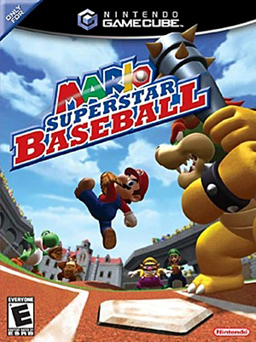
Mario Superstar Baseball is a 2005 sports video game developed by Namco and published by Nintendo for the GameCube. The game was created in the vein of other Mario sports games such as Mario Golf: Toadstool Tour and Mario Power Tennis. A sequel, Mario Super Sluggers, was released for the Wii in 2008.

Mario Party 7 is a party video game developed by Hudson Soft and published by Nintendo for the GameCube in November 2005. The seventh main installment in the Mario Party series, it makes use of the microphone peripheral introduced in Mario Party 6, and features twelve characters, including two new unlockable characters: Birdo and Dry Bones. Koopa Kid was omitted as a playable character, after being playable in the two previous games.

Mario Party 8 is a 2007 party video game developed by Hudson Soft and published by Nintendo for the Wii. It is the eighth main installment in the Mario Party series, as well as the first title in the series to be released for the Wii.

Super Mario is a platform game series created by Nintendo starring their mascot, Mario. It is the central series of the greater Mario franchise. At least one Super Mario game has been released for every major Nintendo video game console. However, there have also been a number of Super Mario video games released on non-Nintendo gaming platforms. There are more than 20 games in the series.
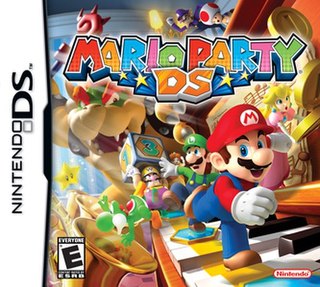
Mario Party DS is a 2007 party video game developed by Hudson Soft and published by Nintendo for the Nintendo DS. It is the second handheld game in the Mario Party series, as well as the last game in the series to be developed by Hudson Soft, as all subsequent titles have been developed by NDcube. The game was later released on the Virtual Console for the Wii U in April 2016.
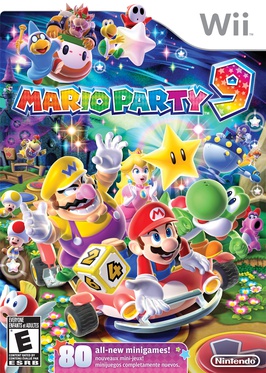
Mario Party 9 is a 2012 party video game developed by NDcube and published by Nintendo for the Wii. The ninth main installment in the Mario Party series, it was announced at E3 2011 and released in Europe, North America, and Australia in March 2012, followed by Japan a month later. It was the first game in the series not to be developed by Hudson Soft, which was acquired and dissolved by Konami on March 1, 2012, the day before the game's European release. Instead, development was taken over by Nintendo studio NDCube. This was also the final Mario game to be released on the Wii.

Wii Party is a party video game developed and published by Nintendo for the Wii video game console. The game heavily borrows game play elements from the Mario Party series, another Nintendo franchise. It is also the first game in the Wii series that Shigeru Miyamoto did not produce. The game was released in Japan on July 8, 2010, in North America on October 3, 2010, in Australia on October 7, 2010, and in Europe on October 8, 2010. Wii Party was revealed by Satoru Iwata in a Financial Results Briefing on May 7, 2010. It received mixed to positive reviews from critics and sold 9.35 million copies worldwide as of September 2021. A sequel, Wii Party U, was released for the Wii U on October 25, 2013.
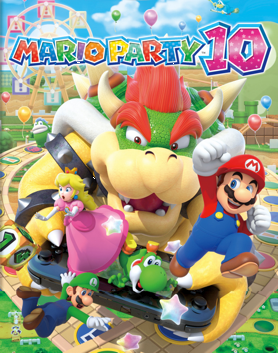
Mario Party 10 is a 2015 party video game developed by NDcube and published by Nintendo for the Wii U video game console. It is the tenth home console release in the Mario Party series and a part of the larger Mario franchise. Featuring gameplay similar to the prior series entries, players compete against each other and computer-controlled characters to collect the most mini-stars, traversing a game board and engaging in minigames and other challenges. There are multiple game modes, including one where players traverse a board in a vehicle, sabotaging each other and making choices to collect the most mini-stars by the end. Mario Party 10 adds two modes over its predecessors: Bowser Party, where four players compete in a team against a fifth who controls Bowser on the Wii U GamePad, and Amiibo Party, where players use Amiibo figures. Their gameplay is interspersed by over 70 minigames with various play styles.
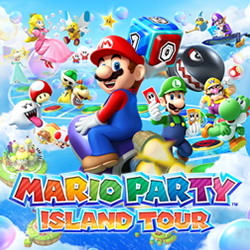
Mario Party: Island Tour is a party video game developed by NDcube and published by Nintendo for the Nintendo 3DS. The third handheld game in the Mario Party series, it was announced by Satoru Iwata in a Nintendo Direct presentation in April 2013, and was released in November 2013 in North America, in January 2014 in Europe and Australia, and in March 2014 in Japan. The game features seven boards, each with their own special features, and 81 new minigames. It was followed by Mario Party 10 for the Wii U in 2015.

Mario Party: Star Rush is a party video game developed by NDcube and published by Nintendo for the Nintendo 3DS. It is the fourth handheld game in the Mario Party series. The game features a new party mode known as Toad Scramble which deviates from the normal Mario Party series in its removal of turn-based gameplay in favor of the ability to move at will, simultaneous with other players, and without set paths on the game board.

Super Mario Party is a party video game developed by NDcube and published by Nintendo for the Nintendo Switch. The eleventh main entry in the Mario Party series, the game was described as a "complete refresh" of the franchise, bringing back and revitalizing gameplay elements from older titles while also introducing new ones to go along with them. It was released worldwide on 5 October 2018 and sold 1.5 million copies by the end of the month. As of December 31, 2023, the game has sold more than 20.34 million copies worldwide, making it one of the top ten best-selling games on the system. Mario Party Superstars, a game featuring maps remastered from earlier entries and a return to the original formula, was released in 2021.

Mario Party Superstars is a 2021 party video game developed by NDcube and published by Nintendo for the Nintendo Switch. It is the twelfth home console installment in the Mario Party series, and the second for the Nintendo Switch following Super Mario Party (2018). It was released on October 29, 2021.




















